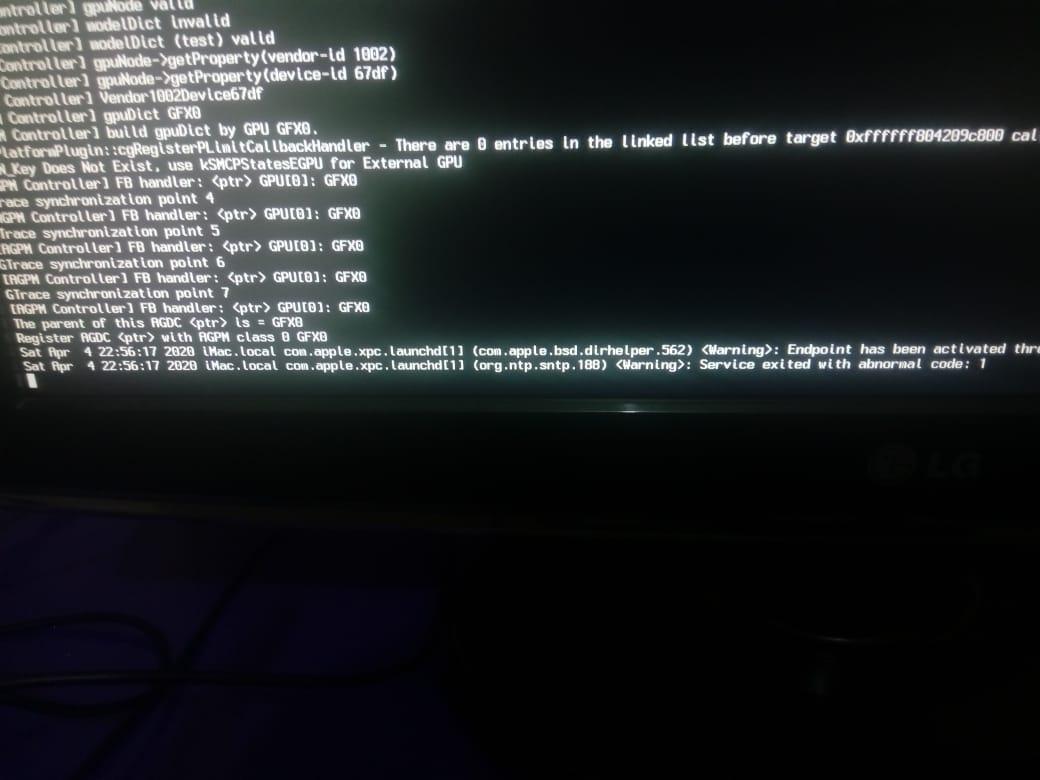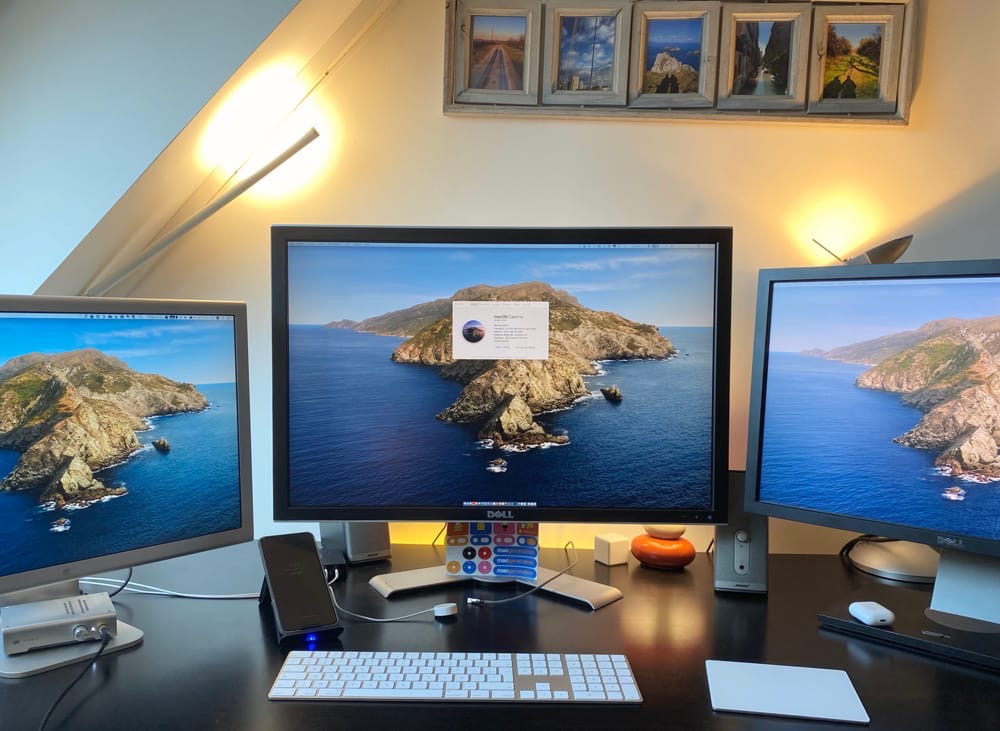- Catalina Hackintosh Iso
- Mac Catalina Hackintosh
- Catalina Hackintosh Build
- Catalina Hackintosh Distro
- Niresh Catalina Hackintosh
macOS 10.15, also known as macOS Catalina, is Mac’s most recent—next-generation—operating system. Apple’s macOS Catalina comes with more to offer compared to its predecessors. A few of this operating system’s features include experience-dedicated apps for podcasts, TV, and music. The best part about this OS is that upgrading is easy and free for all Mac users.
A Hackintosh is a non-Apple branded PC that runs the Apple macOS operating system. To do this, you will need a compatible non-apple PC, as well as access to a Mac computer.
Before getting started, you first have to check if your Mac meets Catalina’s hardware requirements so you can proceed to install it. Here is a list of Mac devices and models compatible with macOS Catalina:
- To install macOS Catalina 10.15 on PC-Hackintosh you have to insert the created Bootable USB to your computer. After that, restart your computer, then press the Boot menu key of your computer. After that, the list of drives will appear whether you want to boot macOS Catalina from USB or CD/DVD.
- Hackintosh Build Guide for OSX Catalina - 10.15 Prerequisites My System Specs Step One: Make a Catalina Bootable USB (the mac approved way) Step Two: Clover Configuration on your USB Get Clover and your kexts (drivers for mac) Minimum Extras for my build USB Drive Config Copying Files to EFI partition on Hackintosh macOS Catalina USB Installer.
- MacBook 2015 and later
- MacBook Air 2012 or later
- MacBook Pro 2012 or later
- Mac Mini 2012 or later
- iMac 2012 or later
- iMac Pro 2017 or later
- Mac Pro 2013 or later
You can follow these steps to find out the kind of Mac you have:
- Navigate to the Apple menu.
- Select About This Mac.
- The Overview tab will display your Mac from the Overview tab.
Important Information About macOS Catalina
In macOS Catalina, Apple no longer supports any 32-bit apps. Therefore, any apps on your Mac that have not been updated from 32-bit to 64-bit will not function on this OS.
To identify the 32-bit apps on your Mac, follow these steps:
- On your screen’s top left corner, click on the Apple icon.
- Select About This Mac.
- At the bottom of the window, click on the button labeled System Report.
- On the window’s left side, click on Applications (under the Software section).
- A list of applications will populate.
- To find the 64-bitcolumn,move to the right using your cursor. Any 32-bit apps will have No listed in this column.
Before you can upgrade to macOS Catalina, there a few things you have to sort out first, such as:
- Confirmation of your Mac’s compatibility for macOS Catalina.
- Creation of a Time Machine backup.
- Ensuring your Mac has sufficient storage to download, install, and upgrade to macOS Catalina.
Creating a Time Machine Backup
Before upgrading to macOS Catalina, it is crucial to create a Time Machine backup. The reason for the backup is a safety measure for when you find your Mac to be incompatible with the Catalina OS, which means you can erase the upgrade and restore it using the backup you created.
Creating a backup whether upgrading or downgrading your Mac is not only a good idea, but also imperative. Unless you would not mind losing everything, we highly recommend creating a Time Machine backup before upgrading to macOS Catalina. Without the backup, it would take a lot of time to restore your system to its previous OS. You would have to download each program, plug-in, and driver once more.
Follow these steps to format an external hard drive for macOS:
- Start Disk Utility, which you can find by navigating to Applications > Utilities > Disk Utility.
- Choose the hard drive device and then click on Erase (if initiated, the process is irreversible)
- Choose a name for your drive (e.g., My Backup) and select the format: Mac OS Extended (Journaled), then click on Erase.
Follow these steps to create a Time Machine backup drive:
- Start Time Machine and click on Select Disk.
- Connect a drive (reformatted or empty).
- Select the drive you have just connected (e.g., My Backup) and click on Use Disk.
- Click on the Backup taskbar icon and then select Backup Now.
Downloading macOS Catalina
The upgrade to the macOS Catalina process involves two steps: backup and installation. After you have created a backup, the next step is visiting the App Store to download the macOS installer. Depending on your internet speed, the download may take some time. Upon completing the download, you can install the macOS Catalina app that you can find in your Applications folder.
Storage Space Required for the Download
macOS Catalina needs storage of 12.5GB to 18GB for upgrading. Therefore, if you have insufficient space on your Mac, you can make a backup of some files then delete them from your system to avail the storage required.
Upgrading from Mac OS X Older Versions
Any older versions of Mac OS X 10.7-10.10 have to first upgrade to Mac OS X El Capitan 10.11 version before upgrading to macOS Catalina, which you can download from Apple’s Catalina download page.
To do this, follow these steps:
- Launch the System Preferences menu, and thenselect Software Update.
- Click on the Download or Upgrade Now button to begin the download of the Catalina installer.
Installing macOS Catalina
Follow these steps to install macOS Catalina:
- After completion of the macOS Catalina installation app download, the installer will automatically launch itself. If not, go to your Mac’s Applications folder and double click the Install macOS Catalina app.
- Follow the instructions that appear on-screen to finish the upgrade and start using the OS.
- Select an external drive to create an external drive for macOS or an internal drive to upgrade the Mac when prompted.
macOS Catalina’s New Features
Follow these steps to complete installing macOS Catalina’s new features:
- After macOS Catalina installs, your Mac will restart.
- After it has started, click on the Apple icon and select About This Mac to view the Catalina OS version.
MacOS (Currently Catalina 10.15.6) working on ThinkPad X230
Status: Work In Progress
DISCLAIMER: Read the entire README before you start. I am not responsible for any damages you may cause.
Introduction
Catalina Hackintosh Iso
| Specifications | Detail |
|---|---|
| Computer model | Lenovo ThinkPad X230 (Type: 2325) |
| Processor | Intel Core i7-3520M (2C4T, 2.9/3.6Ghz, 4MB) |
| Memory | Crucial 16GB DDR3L 1867MHz, dual-channel |
| Hard Disk | Crucial BX500 3D-NAND 240GB |
| Integrated Graphics | Intel HD Graphics 4000 |
| Display | 12.5' HD (1366x768) TN - B125XW01.V0 |
| Audio | Realtek ALC3202 (Layout-id: 18) |
| Ethernet | Intel 82579LM Gigabit Network Connection |
| WIFI+BT | AzureWave AW-CB160H (BCM94360HMB) |
| Keyboard | 6-row, multimedia Fn keys, LED backlight |
| Dock | ThinkPad UltraBase Series 3 |

Mac Catalina Hackintosh
This EFI will suit any X230 regardless of CPU model, amount of RAM, display resolution, and internal storage.
- Optional custom CPU Power Management guide (see below post-install)
- Modified
- 1440p display models should change
NVRAM>>Add>>7C436110-AB2A-4BBB-A880-FE41995C9F82>>UIScale: 2 - X220 7-row keyboard should use :
SSDT-X220-KBD.aml
- 1440p display models should change
| Component | Version |
|---|---|
| MacOS Catalina | 10.15.6 (19G2021) |
| OpenCore | 0.6.1 |
| Kext | Version |
|---|---|
| AirportBrcmFixup | 2.0.9 |
| AppleALC | 1.5.2 |
| BrcmPatchRAM | 2.5.4 |
| EFICheckDisabler | 0.5.0 |
| IntelMausi | 1.0.3 |
| Lilu | 1.4.7 |
| USBPorts | |
| VirtualSMC | 1.1.6 |
| VoodooPS2Controller | 2.1.6 |
| WhateverGreen | 1.4.2 |
| Driver | Version |
|---|---|
| HfsPlus.efi | OcBinaryData |
| OpenRuntime.efi | OpenCorePkg 0.6.1 |
Installation
To install macOS follow the guides provided by Dortania
Useful tools by CorpNewt and headkaze

Complete EFI is available in the releases page
A simple method to install a modified BIOS is available here (no external programmer required).
| Main | Sub #1 | Sub #2 | Sub #3 | Setting |
|---|---|---|---|---|
| Config | Network | Wake On Lan | Disabled | |
| Serial ATA (SATA) | Mode | AHCI | ||
| Advanced | System Agent (SA) configuration | Graphics Configuration | DVMT Pre-Allocated | 128MB |
| DVMT Total Gfx Mem | MAX | |||
| Security | Security Chip | Disabled | ||
| Memory Protection | Execution Prevention | Enabled | ||
| Anti-Theft | Current Setting | Disabled | ||
| Computrace | Current Setting | Disabled | ||
| Secure Boot | Disabled | |||
| Startup | UEFI/Legacy Boot | UEFI Only | ||
| CSM Support | Disabled |
Post-install
For setting up the SMBIOS info, use GenSMBIOS
Run GenSMBIOS, pick option 1 for downloading MacSerial and Option 3 for selecting out SMBIOS
- MacBookPro10,2
Open
Config.plist, find PlatformInfo >> GenericThe
Serialpart gets copied to SystemSerialNumber.The
Board Serialpart gets copied to MLB.The
SmUUIDpart gets copied to SystemUUID.
Reminder that you want either an invalid serial or valid serial numbers but those not in use, you want to get a message back like: 'Invalid Serial' or 'Purchase Date not Validated'Apple Check Coverage
Recommended additional steps to improve battery life with optimized CPU power management:
Open Terminal, copy and paste the following command:
A customized
SSDT.amlfor your specific machine will now be in the directory /Users/yourusername/Library/ssdtPRGenRename to
SSDT-PM.aml, and copy to EFI/OC/ACPI/Open
Config.plist, enableACPI>>Add>>SSDT-PM.amlReboot

If you are using different model and alternative kext from Other folder does not work for you. Try:
Catalina Hackintosh Build
- Download and install ThinkpadAssistant
- Open the app and check the
launch on loginoption
- Go under
SystemPreferences > Keyboard > Shortcuts > Screenshots - Click on
Screenshot and recording optionskey map - Press
PrtScon your keyboard (it should came out asF13)
- Download Binary Resources and OpenCanopy.efi
- Copy the Resources folder to
EFI/OC - Add OpenCanopy.efi to
EFI/OC/Drivers - Make these changes inside
config.plist:Misc >> Boot >> PickerMode:ExternalMisc >> Boot >> PickerAttributes:1UEFI >> Driversand addOpenCanopy.efi
Status
- Battery Percentage
- Bluetooth
- Brightness
- Camera
- CPU Power Management
- Dock Support
ThinkPad UltraSeries 3 - GPU Intel HD 4000 Graphics QE/CI
- Intel Ethernet
- Keyboard
Volume and brightness hotkeys - Sleep/Wake
- Sound
Automatic headphone detection, mute, volume controls fully working - Touchpad
1-4 fingers swipe works - TrackPoint
Works perfectly. Just like on Windows or Linux - eGPU (Thanks lese9855 have confirmed it #11)
- Fingerprint Reader
- VGA
- SD Card Reader (Disable with
SSDT-SDC.aml)

- Trackpoint not working after wake from sleep
Credits
Catalina Hackintosh Distro
Apple for macOS
Niresh Catalina Hackintosh
Acidanthera for all the kexts/utilities that they made
Rehabman and Daliansky for the patches and guides and kexts
George Kushnir for modified BIOS
Dortania for for the OpenCore Install Guide
MSzturc for ThinkpadAssistant
simprecicchiani for inspirational ThinkPad configurations